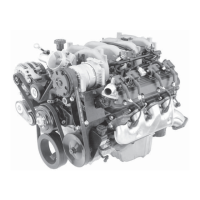WORKHORSE CUSTOM CHASSIS
Service Manual
W SeriesWCC
SECTION
6.2
PAGE
37
Engine Mechanical
W Series Chassis
TOC
© 2006 WorkhorseCustom Chassis — All Rights Reserved
DRIVE BELT CHIRPING, SQUEAL, AND WHINE DIAGNOSIS
Diagnostic Aids
• A chirping or squeal noise may be intermittent due to moisture on the drive belts or the pulleys. It may be necessary to
spray a small amount of water on the drive belts in order to duplicate the customers concern. If spraying water on the
drive belt duplicates the symptom, cleaning the belt pulleys may be the probable solution.
• If the noise is intermittent, verify the accessory drive components by varying their loads making sure they are operated
to their maximum capacity. An overcharged A/C system, power steering system with a pinched hose or wrong fl uid, or a
generator failing are suggested items to inspect.
• A chirping, squeal or whine noise may be caused by a loose or improper installation of a body or suspension component.
Other items of the vehicle may also cause the noise.
• The drive belts will not cause a whine noise.
Test Description
The numbers below refer to the step numbers on the diagnostic table.
2. The noise may not be engine related. This step is to verify that the engine is making the noise. If the engine is not
making the noise do not proceed further with this table.
3. The noise may be an internal engine noise. Removing the drive belts one at a time and operating the engine for a
brief period will verify the noise is related to the drive belt. When removing the drive belt the water pump may not be
operating and the engine may overheat. Also DTCs may set when the engine is operating with the drive belts removed.
4. Inspect all drive belt pulleys for pilling. Pilling is the small balls or pills or it can be strings in the drive belt grooves from
the accumulation of rubber dust.
6. Misalignment of the pulleys may be caused from improper mounting of the accessory drive component, incorrect
installation of the accessory drive component pulley, or the pulley bent inward or outward from a previous repair. Test
for a misaligned pulley using a straight edge in the pulley grooves across two or three pulleys. If a misaligned pulley is
found refer to that accessory drive component for the proper installation procedure for that pulley.
10. Inspecting of the fasteners can eliminate the possibility that a wrong bolt, nut, spacer, or washer was installed.

